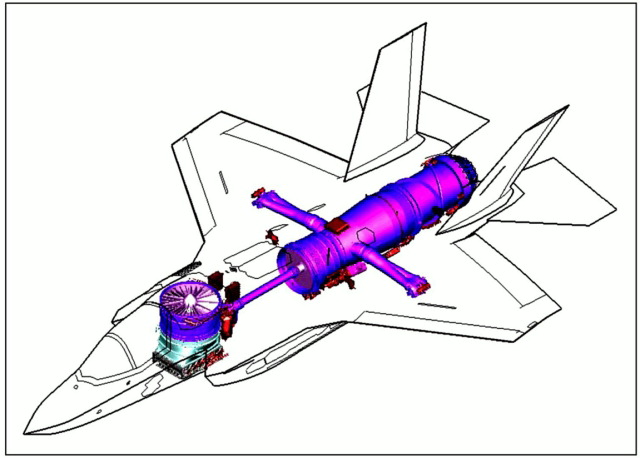
UNIFIED ENGINEERING
Ian A. Waitz
Problem T1. (Unified Thermodynamics) Solutions
Below is a schematic of the engine for the Joint Strike Fighter (JSF). A lift fan (directly behind the cockpit) is driven by a shaft from the main engine to provide vertical take-off and landing capability. The exhaust nozzle on the main engine can also swivel 90 degrees to point directly down. The inlet for the main engine is split, with half of the flow coming in either side of the cockpit, flowing through a y-shaped duct (with the shaft running through it) that wraps around the lift fan and meets in the center of the aircraft. There are also two small roll-control jets that exit the main engine aft of the compressor.
Describe the exchanges of energy (internal, potential, kinetic, chemical) and conversions of heat and work for this system. Start with the fuel and air being mixed in the combustor and the airplane on the ground. End with the airplane hovering at some distance above the ground.
(LO#1, LO#2, LO#3)

The objectives of this problem were two-fold. First, I wanted you to dig-in and learn a little about how turbomachines work. Thus, it is expected that you would have searched around on the web and read about turbomachines in an attempt to unravel some of the pieces and parts. The second objective was to get you to view all of the interworkings of this system as a series of energy exchanges. In the thermodynamics lectures we will learning about a empirical and theoretical rules that govern these energy exchanges.
With that said, this is a very complex device; one of the challenges in answering this question (particularly if you are new to engines and thermodynamics) is to determine the appropriate level of detail with which to analyze the workings of the system. For this problem, I was looking for something between a molecule-by-molecule description and an overly superficial representation (e.g. chemical energy of fuel + air goes to increasing potential energy of airplane). Different students will invariably tackle this at different levels of detail. The key is that your description is based on identifying different forms of energy and the exchanges between them.
Here is my answer:
Chemical energy in the fuel and oxidizer (the oxygen in the air) is converted to internal energy in the combustor (hot, high pressure gas). This internal energy is converted into kinetic energy (a high speed flow) using a nozzle at the exit of the combustor. The high speed flow pushes on (i.e. does work on) a series of blades (the turbine). As a result the energy of the high speed flow is reduced (lower kinetic and internal energy). At this point, the discussion must branch. For the first branch, let's consider the exhaust jet from the back of the engine. For the second branch we will consider the lift fan on the front of the airplane. After passing through the turbine, the flow exits the engine as a hot high speed exhaust (i.e. still with elevated internal and kinetic energy despite some energy being removed in the turbine) where it is vectored downward causing an upward force on the nozzle+airplane (doing work to lift the airplane and increase the potential energy of the system). That is only half of the lift force. The remainder comes from the lift fan. The turbine is connected through a shaft and a gear to the lift fan. So the energy that is extracted from combustor flow by the turbine is ultimately used to do work on the flow passing through the lift fan. The flow enters the lift fan as a cold, low speed flow (internal and kinetic energy) and has work done on it by the spinning fan blades causing it to increase in speed and temperature (kinetic and internal energy). The increase in kinetic energy is more significant than the increase in internal energy, but both change. Since the flow leaves with a higher momentum than it came in with, there must be a balancing force on the surfaces of the lift fan duct that pushes the airplane up (i.e. does work on the airplane), increasing it's potential energy.
In the thermodynamics and propulsion lectures in Unified you will learn a great deal more about all of these processes. I encourage you to go back and think about this problem after you have completed spring term. (I certainly expect it will be much easier for you to answer the question then!)